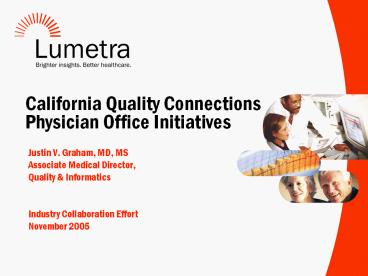California Quality Connections Physician Office Initiatives - PowerPoint PPT Presentation
Title:
California Quality Connections Physician Office Initiatives
Description:
Congestive Heart Failure. Colorectal Cancer. Diabetes. Urinary Tract Infection ... Practices who want sign up for any program. www.lumetra.com/participate ... – PowerPoint PPT presentation
Number of Views:21
Avg rating:3.0/5.0
Title: California Quality Connections Physician Office Initiatives
1
California Quality ConnectionsPhysician Office
Initiatives
- Justin V. Graham, MD, MS
- Associate Medical Director,
- Quality Informatics
- Industry Collaboration Effort
- November 2005
2
Lumetras Mission Vision
- Mission
- To improve the quality, safety, effectiveness,
and integrity of healthcare delivery through
independent review, analysis, and expert
consultation. We create value by focusing on
quality, performance, and customer satisfaction. - Vision
- To transform the quality and integrity of
healthcare systems across the United States.
3
Who Is Lumetra?
- Californias Quality Improvement Organization
(QIO) for Medicare - Independent, non-profit organization dedicatedto
improving the quality, safety, and integrity of
healthcare - Working with healthcare professionals across the
country to provide brighter insights for better
healthcare - Based in San Francisco
- Previously known as CMRI
4
What Is a QIO?
- National network of 53 organizations responsible
for each U.S. state and territory under the
direction of the Centers for Medicare Medicaid
Services (CMS). - Enacted by federal statute to improve the
efficiency, effectiveness, economy, and quality
of services delivered to Medicare
beneficiaries. - Work with consumers, physicians, hospitals, and
other caregivers to refine care delivery systems
and make sure patients get the right care at the
right time.
5
California Quality Connections 2005 - 2008
- Hospitals
- Appropriate care for MI, CHF, and pneumonia
- Surgical Care Improvement Program (SCIP)
- CPOE, Barcoding, and Telehealth (rural)
- Organizational culture supporting patient safety.
- Critical access hospitals quality improvement
- Nursing Homes
- Pressure ulcers,
- Use of physical restraints
- Management of depressive symptoms
- Organizational culture change
- Home Health Agencies
- Reduction in acute care hospitalizations
- Immunizations
- Telehealth
- Physician Offices
- Using information technology
- Addressing the needs of the underserved
- Cultural competency
- Immunizations
- Mammography
- Diabetes and CHF care
- Improving prescription drug delivery and
medication use
6
The Case for Quality Improvement
- Outpatients receive only 55 percent of
recommended care
22.8
Hip Fracture
24.7
Atrial Fibrillation
39.0
Community Acquired Pneumonia
40.7
Urinary Tract Infection
45.4
Diabetes
53.9
Colorectal Cancer
63.9
Congestive Heart Failure
64.7
Hypertension
68.0
Coronary Artery Disease
McGlynn, et al. NEJM 2003 3482635-2645
7
The Case for Quality Improvement
25
Gandhi, et al. NEJM 2003 3481556-1564
Clinicians are missing essential patient
information at 13.6 of visits
13.6
Smith, et al. JAMA 2005 293565-571.
Outpatient Visits
8
Hard Dollar Benefits of EHR
Example
Conditions
Amount
Capture lost charges IF charges are now being lost 1 - 5 revenue gain
Reduce defensive downcoding IF downcoding is prevalent 5 - 11 revenue gain
Reduce claims denials delays IF denials or delays are common 15 30 day A/R speedup
Increase preventive and management services IF new services are profitable AND capacity exists 5 revenue gain
Reduce transcription IF dictating AND willing to change 5k - 15k/yr costs cut
Hard DollarBenefits
M. Leavitt. EHR in the Small Practice, November
2004.
9
Impact of EHR
Zaroukian, M, EMR Cost/Benefit Analysis, GE
Healthcare EMR User Group, 2004
10
The Tipping Point?
Medical Economics, Jan. 21, 2005
11
DOQ-IT Pilot Project
- Goal Promote Adoption of EHR Systems
- CMS-sponsored 2-year Special Study in partnership
with American Academy of Family Physicians (AAFP) - Incorporates four QIOs
- California (Lead QIO)
- Arkansas, Massachusetts, Utah
- Implement in 150-200 small- to medium-sized
practices in each state - Primary care focus (FP, IM)
- Provide a national model for ALL QIOs
- Physician efficiency and adoption
- Chronic care performance focus
- Patient safety and outcomes
12
California Quality Connections 2005 - 2008
- Scale up to 1,000 practices
- Geographically dispersed in California
- Rural and urban settings
- Only primary care practices who see Medicare
patients - Our goals
- Practices without pre-existing HIT (gt 80)
- Implement HIT system(s) ? 75
- Implement care management processes ? 30
- Practices with pre-existing HIT (lt 20)
- Implement care management processes ? 75
13
DOQ-IT Curriculum
- Nine to twelve month Guided Tour to EHR
Implementation featuring - Peer-to-Peer Support Network
- Workshops
- Teleconferences
- Web Forum
- Personalized Assistance
- Online tools and surveys
- Tailored materials and resources
- Scheduled milestones
- Starting November 2005
14
Curriculum Topics
- Introduction to EHR and Informatics
- Change Management
- Practice Improvement Opportunities
- Building a Business Case
- Prepare Your Practice for an EHR
- EHR Selection Guidelines
- Making the Purchase
- How to Deal with Paper
- Rollout Strategy
- Transitioning to System Improvement
- Population Management
15
Benefits to Physician Offices
- Assistance with needs assessment
- Guidance for EHR vendor selection
- Advice during implementation
- Support for creating efficient practice processes
- Improved chronic and preventative care management
- Increased patient safety
- Preparation for Pay-for-Performance data
collection
16
Medicare Pay-For-Performance
- Medicare Care Management Performance
- 3-year CMS-sponsored Pay-for-Performance project
- Four state demonstration AR, CA, MA, UT
- 800 practices (250 in CA)
- Begins in Winter 2005
- Clinical performance and HIT systems adoption
measures - Up to 10,000 / provider for each component
annually - Maximum of 50,000 / practice for each component
annually
17
Interested?
- Practices who want sign up for any program
- www.lumetra.com/participate
- For more materials or to hear an informational
teleconference - Contact Glen Moy
- gmoy_at_caqio.sdps.org
- 415.677.8428
- Partnership opportunities
- Contact Justin V. Graham, MD, MS
- jgraham_at_caqio.sdps.org
- 415.677.2163































